Filling Lake Mead with Mississippi River Water No Longer a Pipe Dream
Posted on: February 7, 2023, 02:30h.
Last updated on: February 10, 2023, 10:54h.
Despite recent rains, the water level in Lake Mead – which supplies Las Vegas with 90% of its water – was 1,046.94 feet above sea level on Feb. 2. That’s only 28% of its full capacity. And cutting water use, even drastically, may not solve the problem.
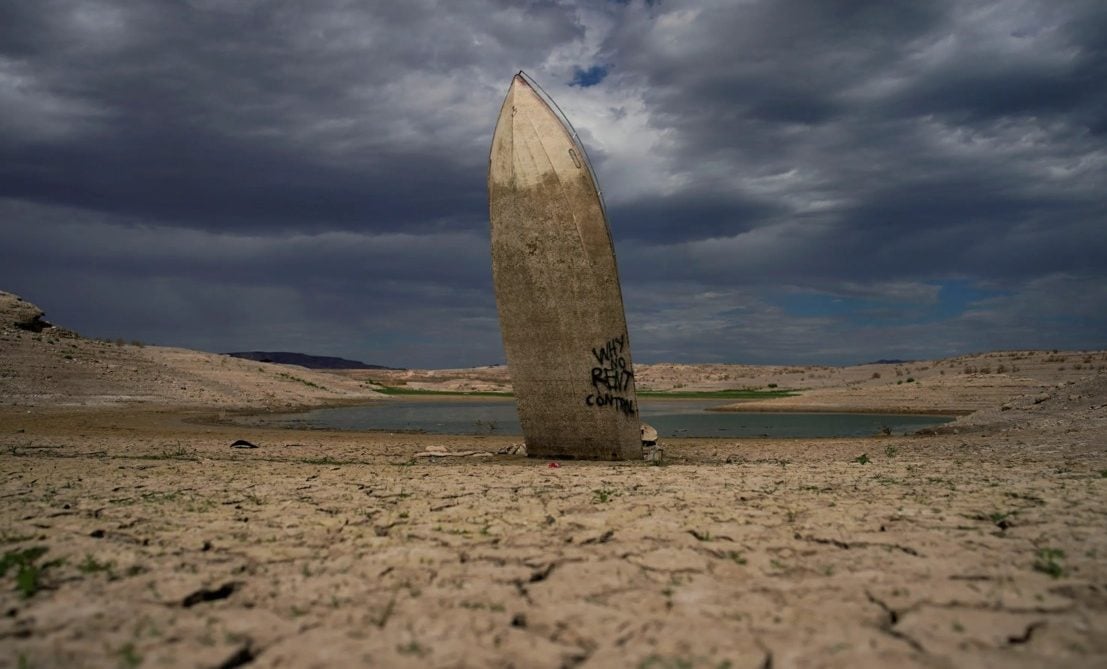
Because of climate change, some estimates predict that the Colorado River may deliver only half its current amount of water by the year 2100.
Pumping Mississippi River water into Lake Mead has been suggested before. But as water levels drop – threatening to eventually cut off California, Arizona, and Mexico from their Colorado River water allotments – and as engineering technology advances, large-scale river diversion doesn’t seem as much of a pipe dream as it once did.
In 2021, the Arizona state legislature actually passed a measure urging Congress to investigate pumping flood water from the Mississippi to the Colorado to boost its flow. Studies show that a project like this would be possible, though it would take decades of construction and billions of dollars. Maybe even trillions.
“I think it would be foolhardy to dismiss it as not feasible,” Richard Rood, professor of Climate and Space Sciences and Engineering at the University of Michigan, told the Cedar Rapids Gazette. “But we need to know a lot more about it than we currently do.”
Large-scale river diversion projects have been proposed in the US since the 1960s when an American company sought to redistribute Alaskan water across the continent using canals and reservoirs. That plan never generated enough support – a fate shared by similar proposals in Minnesota and Iowa.
Still Too Pricey … For Now
In 2012, the U.S. Department of the Interior’s Bureau of Reclamation performed a Colorado River Basin analysis considering several solutions to the current drought – including importing water from the Missouri and Mississippi Rivers.
Under the analyzed scenario, water would be diverted to Colorado’s Front Range and areas of New Mexico. That would cost at least $1,700 per acre-feet of water, potentially yield 600,000 acre-feet of water per year by 2060, and take 30 years to construct.
A decade later, Roger Viadero, an environmental scientist and engineer at Western Illinois University, calculated that moving this scale of water would require a pipe 88 feet in diameter – twice as long as a semi-trailer – or a 100-foot-wide channel that’s 61 feet deep.
“As an engineer, I can guarantee you that it is doable,” Viadero told the Cedar Rapids Gazette. “But there are tons of things that can be done but aren’t ever done.”
Viadero’s team estimated the cost of buying enough water to fill up the Colorado River’s Lake Mead and Lake Powell at more than $134 billion, assuming a penny per gallon. Add to that heavy construction costs and the costs of powering the equipment needed to pump the water over the Western Continental Divide. Buying the land to secure water rights would be very costly, too.
Politics: The Other Problem
The political hurdles are also considerable. They include wetlands protections, endangered species protections, drinking water supply considerations, and interstate shipping protections. Precedents set by other diversion attempts – such as the ones that created the Great Lakes Compact, also cast doubt over the political viability of any large-scale Mississippi River diversion attempt.
And transnational pipelines would also impact ecological resources. Lower Mississippi River flow means less sediment carried down to Louisiana, where it’s needed for coastal restoration. Diverting that water also means spreading problems, like pollutants, excessive nutrients, and invasive species such as Asian carp.
None of this even considers the most important question: Is there even enough water to spare? The Mississippi River basin may no longer be a reliable answer to the Colorado River basin’s problem since the Mississippi is drying up, too. Water levels are at or below the low-water threshold along a nearly 400-mile stretch of the river. This past year, sunken boats, such as the Diamond Lady riverboat casino, are surfacing like bodies are in Lake Mead.
“No one wants to leave the western states without water,” Melissa Scanlan, a freshwater sciences professor at the University of Wisconsin-Milwaukee, told the Cedar Rapids Gazette. “But moving water from one drought-impacted area to another is not a solution.”
Growing Precedent
Still, there is hope. Last year, a Kansas groundwater management agency received a permit to truck 6,000 gallons of Missouri River water into Kansas and Colorado to recharge an aquifer. Several approved diversions already drain water from the Great Lakes. And in northwestern Iowa, a river has repeatedly been pumped dry by a rural water utility that sells at least a quarter of the water outside the state. And there
In July 2022, former Arizona Gov. Doug Ducey signed legislation investing $1.2 billion into projects that conserve water and bring more into the state. Among its provisions, the law granted Arizona’s water infrastructure finance authority to “investigate the feasibility” of potential out-of-state water import agreements.
And, as the tired adage goes, desperate times call for desperate measures. According to a two-year projection by the federal Bureau of Reclamation, by the end of July 2024, Lake Mead’s water level could fall to as low as 992 feet above sea level. That’s perilously close to a dead pool (895 feet), the point when a reservoir is so low gravity will no longer allow it to release water downstream. If and when Lake Mead hits this point, that will be dire news for downstream regions, including Los Angeles, Phoenix, San Diego, Tucson, and Mexico.
“It’s possible that the situation gets so dire that there is an amount of money out there that could overcome all of these obstacles,” Rhett Larson, an Arizona State University professor of water law, told the Cedar Rapids Gazette. “It might be in the trillions, but it probably does exist.”
In the meantime, researchers encourage more feasible and sustainable options, such as better water conservation, water recycling, and less agricultural reliance.
Related News Articles
Colorado River Snowpack Reaches 158%, Easing Las Vegas Drought
Lake Powell Water Loss Captured in Shocking New Photos
Lake Mead Rose in August Thanks to Las Vegas Rains, But by a Drop in the Bucket
Most Popular
IGT Discloses Cybersecurity Incident, Financial Impact Not Clear
Sphere Threat Prompts Dolan to End Oak View Agreement
This Pizza & Wings Costs $653 at Allegiant VIP Box in Vegas!
MGM Springfield Casino Evacuated Following Weekend Blaze
Most Commented
-
VEGAS MYTHS RE-BUSTED: Casinos Pump in Extra Oxygen
— November 15, 2024 — 4 Comments -
Chukchansi Gold Casino Hit with Protests Against Disenrollment
— October 21, 2024 — 3 Comments -
VEGAS MYTHS RE-BUSTED: The Final Resting Place of Whiskey Pete
— October 25, 2024 — 3 Comments
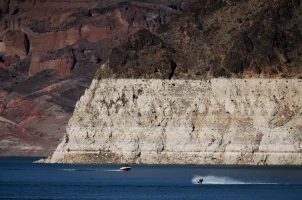
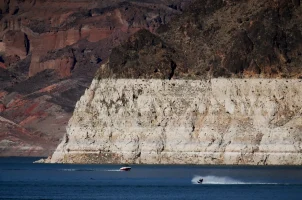
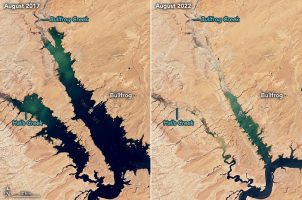
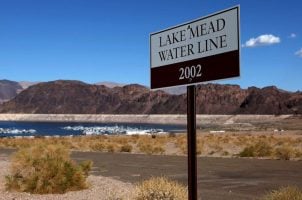












Last Comments ( 177 )
Desalination from the Pacific,problem solved.
Explain why the salt waste from desalination is a “No Go.” How does Saudi Arabia manage it? There have to be tons of usable minerals in the waste product. Why can’t the salt be processed for a usable end product?
Y'all know the problem with desalination? Salt! Lots and lots of it. You can't pump that back into the ocean. Salt on or in the ground kills it. If you have a bright idea of what to do with it, California is all ears.
Diverting the water that flows from the Mississippi River will be the catastrophic end to farmland and the life of the Southern states plants animals and humans...this is the most absolutely worst idea EVER!!! You want water in the southwest? Tell California to restart those desalination pumps that are shut down for no reason!!! The largest body of water on the planet is connected to it...
Off Al gore and a few others and tear down wi d turbines and everything will go back to normal
Why does the idea of desalination seem so taboo. The Pacific is closer. If congressional members are willing to spend Trillions on a Mississippi project why not divert those funds to the west coast. The Earth is 70% water.
For an answer to a comment. The vast majority of people living in Southern Nevada think the building of new homes is lunacy at this point in time. But the "mob" that was run out of the casino business reverted back to the construction business. Padding the pockets of the country Commissioners who approve the building permits. Thus, they will have the funds to leave town and relocate when the water finally runs out. Where is the FBI?
And yet, they keep allowing builders to build more and more homes and apartments. Have them find the water to supply these projects instead of forcing residents to cut back water usage.
This project could have serious ecological effects on the watershed area of Louisiana. This is a bad idea. Diversion methods have proven to have devastating affects in the Middle East wetlands. Let's try to learn from mistakes of others and stop ice skating up hill. This project will only be a temporary fix to a larger issue that will leave an even larger ecological hole in our environment.
How come they want make a the desalination plant from the ocean and pump fresh water to lake Mead and it will never be low again the ocean never runs of water and the problem will be solved wake up while still have chance to fill it people time is running out
Why is desalination not be used to purify ocean water. This is much closer to dry western areas and there now? I have always heard it is to costly but the above solutions are costly and a long ways down the road. Saudi Arabia supplies it whole county with purified ocean water. This seems like a no brained. Thank you
Spelling correction desalination.....
What about Pacific ocean desalinization plants.
Build a pipeline from the Columbia River in Oregon
There is no comment on Damming the Mississippi to hold back water during wet seasons. This would prevent flooding by the Mississippi year after year and save Billions is recovery funds for property damage like katrina.